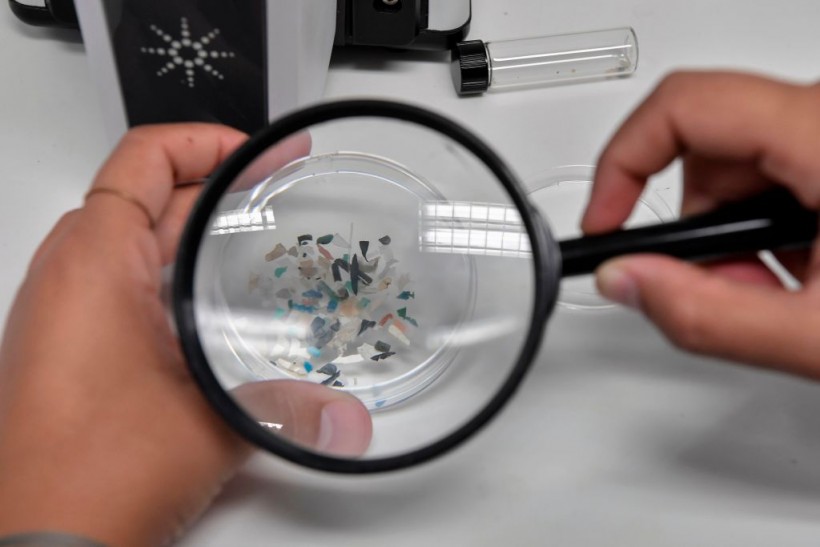In a groundbreaking study, scientists have unveiled a hidden danger lurking in the bottled water that many of us consume daily.
Using advanced imaging technology, researchers have discovered hundreds of thousands of previously uncounted tiny plastic bits, raising concerns about their impact on human health and ecosystems.
A Closer Look at Microplastics
 (Photo : LOUISA GOULIAMAKI/AFP via Getty Images)
(Photo : LOUISA GOULIAMAKI/AFP via Getty Images)

Scientists from the Columbia Climate School employed lasers to illuminate the invisible threat of microplastics residing in bottled water.
These particles are so minute that they escape standard filtration processes and detection methods. The discovery underscores an urgent need for enhanced filtration technologies and stricter regulations on plastic use and disposal.
The presence of these particles is not confined to a specific brand or region; it's a global concern. Every sip of bottled water potentially carries with it an infusion of microplastics, leading to inadvertent consumption by billions of people worldwide.
The study analyzed 250 bottles from 11 brands purchased from nine countries, and found that 93% of bottled water contains microplastics, particles too small to see with the naked eye but potentially hazardous to human health.
The average concentration of plastic particles across brands was 325 microplastic particles per liter of bottled water, but some samples contained more than 10,000 microplastic particles per liter.
The researchers also used a newly refined technology to detect even smaller plastic particles, known as nanoplastics, that measure less than 1 micrometer in length.
They found that a liter of water in a plastic bottle contained an average of about 240,000 detectable plastic fragments - 10 to 100 times more than previous estimates.
Also Read: Recycled Plastics Harm Environment by Leaking Hazardous Chemicals, According to Experts
Implications for Health and Environment
The ingestion of microplastics and nanoplastics is not without consequences. Though research into the effects on human health is still in its infancy, early findings suggest potential disruptions to various bodily systems.
Ecosystems are not immune either; these particles permeate soil, air, and water, affecting both flora and fauna.
As scientists delve deeper into this issue, questions about the long-term impacts on biological systems abound. There's an urgent call for comprehensive studies to understand the breadth and depth of implications fully.
Some animal and lab studies suggest that microplastics may raise cancer risk and pose harm to the human digestive, reproductive, and respiratory systems.
Research also has linked micro- and nanoparticles to disrupting thyroid and endocrine function, obesity, and insulin resistance.
These plastic particles can also pass through the body's protective tissues and into the bloodstream and organs, and even the brain. They can also cross through the placenta to the bodies of unborn babies
Moreover, these plastic particles can act as magnets for pollutants, such as pesticides, heavy metals, and organic contaminants, that may further increase their toxicity.
These pollutants can then be transferred to the organisms that ingest them, potentially causing bioaccumulation and biomagnification along the food chain.
The study also raises questions about the sources and pathways of microplastic and nanoplastic contamination in bottled water.
Plastic particles can break off and get into bottled water when bottles are squeezed or when caps are unscrewed or screwed back on. Excessive heat exposure can also cause plastic to break down.
The researchers suggest that more attention should be paid to the production, storage, and transportation of plastic bottles, as well as the disposal and recycling of them.
Related article: Plastic Recycling Fails as Only a Mere 5% of Plastics from the US was Recycled
© 2024 NatureWorldNews.com All rights reserved. Do not reproduce without permission.

![Tsunami Hazard Zones: New US Map Shows Places at Risk of Flooding and Tsunamis Amid Rising Sea Levels [NOAA]](https://1471793142.rsc.cdn77.org/data/thumbs/full/70325/280/157/50/40/tsunami-hazard-zones-new-us-map-shows-places-at-risk-of-flooding-and-tsunamis-amid-rising-sea-levels-noaa.jpg)



